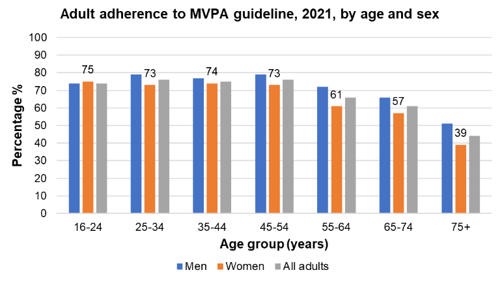This summary outlines the key data and recent findings on women and girls in sport and participation in physical activity. Overall, research shows that women and girls participate less in sport and physical activity than men and boys. This summary identifies the barriers to women and girls’ participation in physical activity, offers practical suggestions to improve inclusion in sport, and provides links to relevant further reading.
Physical activity levels
Women

Data from the 2021 Scottish Health Survey shows that 65% of women meet the MVPA guidelines, compared to 73% of men.
Research indicates that women’s physical activity levels differ during the lifecycle. Among 16-24 year olds, more women (75%) meet recommended physical activity levels than men (74%). Thereafter, women’s physical activity levels fall below men’s. In Scotland, the gap in physical activity is widest between men and women over 75. Among this age group, just 39% of women meet recommended physical activity levels.

Girls
Data from the 2021 Scottish Health Survey indicates that sex differences in physical activity levels begin in childhood. Across all age groups, fewer girls adhere to the MVPA guidelines than boys. The greatest difference is between boys and girls aged 13-15.

Boys are more likely to meet recommended physical activity levels than girls, including school-based activities (76% of boys compared to with 67% of girls) and excluding school-based activities (66% and 55% respectively).

School activity
According to our Active Schools data, girls made up 46% of participants in 2021/22. Relative to the school roll, girls engaged with the programme less than boys. 29% of girls took part in Active Schools sessions, in contrast to 33% of boys.
Primary school pupils participated at a similar rate (37% of girls and 38% of boys). Participation at secondary schools dropped at a higher rate for girls, which lead to a wider gap (20% of girls and 26% of boys).
Club activity
2021 SGB club data shows that of all club members in Scotland (645,502), just 26% are female (102,245 women and 67,276 girls).
Barriers to physical activity and sport
There are several barriers that impact on women’s participation in sport and physical activity. Women in Sport identified the following:
- Gender stereotyping and traditional gendered perceptions of sport
- Costs (e.g. clothing, equipment, memberships, travel)
- Gendered division of caring responsibilities
- Male-dominated environments in sport, including sport governance
- Lack of media coverage on women’s sport.
Research indicates that women of all ages cite body image as a demotivator for taking part in physical activity. Research by the Young Women’s Movement Scotland (2019) showed that 74% of young women (aged 16-30) said that their body image affected their participation in sport and exercise activities. For women with caring responsibilities, gendered division of labour can impact on disposable time and income to spend on sports and physical activity engagement. UK-wide research on physical activity and menopause indicates that 23% of women aged 45-54 are inactive and 38% of women aged 45-54 do not meet CMO guidelines. A further 30% of women surveyed said they were ‘less active’ during menopause.
Supporting women and girls’ inclusion
Our 2016 Sport and Equality Research provides practical measures that can be undertaken to increase women and girls’ inclusion and participation. Support may include:
- Consult women and girls about what they want and need.
- Offer a range of opportunities (contact, non-contact; mixed, single-sex sport; team, individual sport)
- Add socialising opportunities
- Consider the environment (e.g. use community centres and schools instead of sports clubs)
- Tackle stereotypes, prejudice and discriminatory behaviours
- Support women to become involved as coaches, volunteers and decision makers in sport, and help ensure positive decisions are made about sport in Scotland.
Further reading
Women For Sport have produced a report on teenage girls’ disengagement, highlighting the barriers and challenges girls face (e.g. feeling unsafe exercising outside, feeling judged). The report includes ways to support teenage girls to participate in physical activity.
Fit for Girls is a national programme developed in partnership between sportscotland and the Youth Sport Trust. We offer support to local authorities, governing bodies and other national partners who have identified a need to improve the provision for girls and young women and are committed to empowering girls as part of that process.
The sportscotland Women and Girls Fund Evaluation has useful information about best practice for greater inclusion of women and girls in sport and physical activity. It demonstrates how funding can be used to provide targeted support for women and girls.
A series of learning notes has been developed based on findings from the 2016 sportscotland Sport and Equality research. The guidance on women in sport highlights barriers to women’s sport participation and ways to increase inclusion.
The 2020 BBC Elite British Sportswomen Survey summarises the issues that affect women and girls that take part in elite sport (e.g. sexism, how menstruation effects performance, inequal pay).
